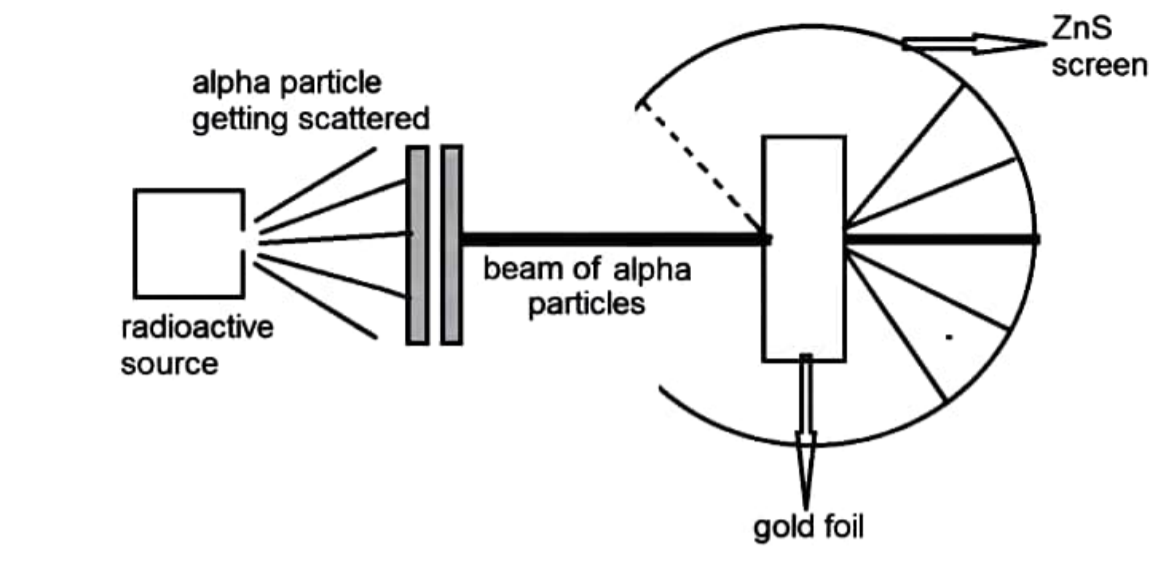
What Is Rutherford’s atomic model? What are the reasons for failure?
Answer
409.5k+ views
1 likes
Hint: Rutherford Atomic Model - J. J. Thomson's plum pudding model failed to explain some experimental results related to atomic structure of elements. Ernest Rutherford, a British physicist, carried out an experiment and, based on the results, suggested the atomic structure of elements, coining the term "Rutherford Atomic Model."
Complete answer:
The Alpha Scattering Experiment of Rutherford:
Rutherford carried out an experiment in which he bombarded a thin sheet of gold foil with -particles and then analysed the track of these particles after they collided with the gold foil.

In his experiment, Rutherford focused high-energy -particle streams from a radioactive source at a thin sheet of gold (100 nm thickness). He wrapped a fluorescent zinc sulphide screen around the thin gold foil to investigate the deflection generated by the -particles. Certain observations obtained by Rutherford contradicted Thomson's atomic model.
Atomic Model of Rutherford
Rutherford suggested the atomic structure of elements based on the preceding findings and conclusions. The Rutherford atomic model states:
Positively charged particles and the majority of an atom's mass were concentrated in a very small volume. This part of the atom was dubbed a nucleus by him.
The Rutherford model stated that the nucleus of an atom is surrounded by negatively charged electrons. He also claimed that the electrons that surround the nucleus travel in circular routes at great speeds. These circular routes were given the name orbits by him.
The nucleus is held together by a strong electrostatic force of attraction because electrons are negatively charged and the nucleus is a densely concentrated mass of positively charged particles.
Rutherford's atomic model failed for the reasons listed below.
(1) It was unable to explain the electrons' orbital stability.
2)Electrons revolving in s. orbits accelerate charged particles, which release energy-carrying electromagnetic radiation.
3)The electron will spiral along a spiral pattern as it loses energy, eventually falling into the nucleus. Electrons cannot exist outside the atom in this fashion.
Note:
As an explanation for the surprising experimental results, Rutherford proposed his own physical model for subatomic structure. The atom is made up of a core charge (the current atomic nucleus), which is surrounded by a cloud of (supposedly) orbiting electrons. Rutherford did not use the term "nucleus" in his work. Rutherford only committed himself to a small centre region of very high positive or negative charge in the atom in this May
Complete answer:
The Alpha Scattering Experiment of Rutherford:
Rutherford carried out an experiment in which he bombarded a thin sheet of gold foil with -particles and then analysed the track of these particles after they collided with the gold foil.

In his experiment, Rutherford focused high-energy -particle streams from a radioactive source at a thin sheet of gold (100 nm thickness). He wrapped a fluorescent zinc sulphide screen around the thin gold foil to investigate the deflection generated by the -particles. Certain observations obtained by Rutherford contradicted Thomson's atomic model.
Atomic Model of Rutherford
Rutherford suggested the atomic structure of elements based on the preceding findings and conclusions. The Rutherford atomic model states:
Positively charged particles and the majority of an atom's mass were concentrated in a very small volume. This part of the atom was dubbed a nucleus by him.
The Rutherford model stated that the nucleus of an atom is surrounded by negatively charged electrons. He also claimed that the electrons that surround the nucleus travel in circular routes at great speeds. These circular routes were given the name orbits by him.
The nucleus is held together by a strong electrostatic force of attraction because electrons are negatively charged and the nucleus is a densely concentrated mass of positively charged particles.
Rutherford's atomic model failed for the reasons listed below.
(1) It was unable to explain the electrons' orbital stability.
2)Electrons revolving in s. orbits accelerate charged particles, which release energy-carrying electromagnetic radiation.
3)The electron will spiral along a spiral pattern as it loses energy, eventually falling into the nucleus. Electrons cannot exist outside the atom in this fashion.
Note:
As an explanation for the surprising experimental results, Rutherford proposed his own physical model for subatomic structure. The atom is made up of a core charge (the current atomic nucleus), which is surrounded by a cloud of (supposedly) orbiting electrons. Rutherford did not use the term "nucleus" in his work. Rutherford only committed himself to a small centre region of very high positive or negative charge in the atom in this May
Recently Updated Pages
Express the following as a fraction and simplify a class 7 maths CBSE

The length and width of a rectangle are in ratio of class 7 maths CBSE

The ratio of the income to the expenditure of a family class 7 maths CBSE

How do you write 025 million in scientific notatio class 7 maths CBSE

How do you convert 295 meters per second to kilometers class 7 maths CBSE

Write the following in Roman numerals 25819 class 7 maths CBSE

Trending doubts
Give 10 examples of unisexual and bisexual flowers

Draw a labelled sketch of the human eye class 12 physics CBSE

Franz thinks Will they make them sing in German even class 12 english CBSE

Draw a diagram of a flower and name the parts class 12 biology ICSE

What is the Full Form of PVC, PET, HDPE, LDPE, PP and PS ?

The speed of light will be minimum while passing through class 12 physics CBSE




